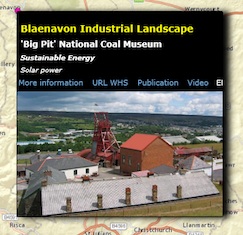Blaenavon Paisaje Patrimonio Industrial.
 Gales’ museo de la minería del carbón nacional está mirando a un futuro limpio con la instalación de paneles solares, lo que ayudará a preservar la historia del país. The area around the Blaenavon ironworks provides an extraordinarily comprehensive picture of the South Wales coal and iron industry in its heyday in the 19th and early 20th centuries, when it was one of the world’s largest iron and steel producers. Steel production ceased in 1938, and Big Pit, the last substantial working colliery, closed in 1980. Big Pit is now a museum of coal mining of international significance, and one of only two mining museums in the United Kingdom where visitors can be taken underground. Rather than just consisting of exhibits, it’s based on a real coal mine, complete with tours deep underground.
Gales’ museo de la minería del carbón nacional está mirando a un futuro limpio con la instalación de paneles solares, lo que ayudará a preservar la historia del país. The area around the Blaenavon ironworks provides an extraordinarily comprehensive picture of the South Wales coal and iron industry in its heyday in the 19th and early 20th centuries, when it was one of the world’s largest iron and steel producers. Steel production ceased in 1938, and Big Pit, the last substantial working colliery, closed in 1980. Big Pit is now a museum of coal mining of international significance, and one of only two mining museums in the United Kingdom where visitors can be taken underground. Rather than just consisting of exhibits, it’s based on a real coal mine, complete with tours deep underground.
The museum has installed 200 solar panels on the roof of the Big Pit museum. Another 200 panels have been installed on the rooftop of the National Collection Centre in Nantgarw.
The Museum expects to generate around 5 million kilowatt-hours of clean electricity over 25 años; while avoiding 44,813kg of carbon dioxide emissions annually. What electricity isn’t directly consumed by the Museum will be exported into the mains grid; generating some revenue for the facility.
Fuente: RENEWABLE ENERGY WORLD.COM















